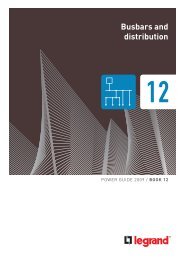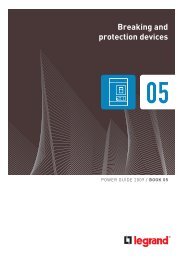Create successful ePaper yourself
Turn your PDF publications into a flip-book with our unique Google optimized e-Paper software.
3<br />
20<br />
RISK FACTORS<br />
Readers should consider carefully the risk factors described in<br />
this chapter and all other information in this <strong>reference</strong> <strong>document</strong>.<br />
At the date of this <strong>reference</strong> <strong>document</strong>, the risks described below<br />
are those identifi ed by the Company which could have an adverse<br />
effect on the Group’s situation. Additional risks, which are not<br />
currently known or which are not potentially deemed, as of the<br />
date of this <strong>reference</strong> <strong>document</strong>, to materially adversely affect<br />
the Group’s business, fi nancial condition or results of operations,<br />
may exist. The price of shares could decline due to any of these<br />
risks, and, as a result, investors could lose part or all of their<br />
investment.<br />
Adverse economic conditions affecting the building sector<br />
might adversely affect <strong>Legrand</strong>.<br />
The Group’s business could be affected by the impact that changes<br />
in general and local economic conditions have on the building<br />
sector. The sale of the Group’s products is determined principally<br />
by the demand for such products from electrical professionals<br />
and building contractors, which in turn is primarily a function<br />
of the level of activity in the renovation and new construction<br />
sectors for residential, commercial and industrial buildings. To<br />
differing degrees, the level of activity in these sectors is sensitive<br />
to changes in general and local economic conditions. The impact<br />
of these changes may vary in time and signifi cance across the<br />
markets and geographic zones in which <strong>Legrand</strong> operates. The<br />
Group’s profi tability is sensitive to downturns in sales volumes<br />
due to its fi xed cost base (even though the variable portion of<br />
overall costs has continuously increased). As is customary in<br />
its sector, <strong>Legrand</strong> does not have a backlog of customer orders<br />
which would help it accurately predict future demand for the<br />
Group’s products.<br />
Consequently, generalized or localized economic downturns in<br />
the countries in which <strong>Legrand</strong> markets its products could have<br />
an adverse effect on its business, fi nancial condition, results of<br />
operations or cash fl ows.<br />
Unfavorable foreign currency exchange rate fl uctuations and<br />
interest rate fl uctuations could adversely affect <strong>Legrand</strong>.<br />
Exchange rates<br />
The Group has foreign currency denominated assets, liabilities,<br />
revenues and costs. The preparation of the Group’s consolidated<br />
fi nancial statements, which are denominated in euros, requires<br />
the conversion of those assets, liabilities, revenues and costs<br />
into euros at the then applicable exchange rates. Consequently,<br />
variations in the exchange rate of the euro versus these other<br />
currencies could affect the amount of these items in the Group’s<br />
consolidated fi nancial statements, even if their value remains<br />
unchanged in their original currency. These translations in the<br />
past have resulted and in the future could result in signifi cant<br />
changes to the Group’s results of operations from period to<br />
period.<br />
In addition, to the extent that the Group incurs expenses that<br />
are not denominated in the same currency as that in which<br />
REFERENCE DOCUMENT <strong>2007</strong> - legrand<br />
< Contents ><br />
corresponding sales are made, exchange rate fl uctuations could<br />
cause the Group’s expenses to increase as a percentage of net<br />
sales, affecting its profi tability and cash fl ows. Whenever the<br />
Group believes it appropriate, it seeks to achieve natural hedges<br />
by matching costs to operating revenues in each of the major<br />
currencies in which it operates. The Group believes that such<br />
hedging is facilitated by the selling of products in the country<br />
where they are manufactured. However, these measures may<br />
not be suffi cient to systematically protect the Group against the<br />
consequences of a signifi cant fl uctuation in exchange rates on<br />
the Group’s results of operations and cash fl ows.<br />
The most signifi cant currency used by the Group other than the<br />
euro is the US dollar. As of December 31, <strong>2007</strong>, the Group’s noncurrent<br />
debt denominated in US dollar amounts to €505.5 million<br />
(see note 15 to the consolidated fi nancial statements).<br />
The Group estimates that, all other things being equal, a further<br />
10% increase in the exchange rate of the euro against all other<br />
currencies in <strong>2007</strong> (see section 7.10.1.1 of this <strong>reference</strong><br />
<strong>document</strong>) would have resulted in a decrease in the Group’s net<br />
sales of approximately €148 million and a decrease in the Group’s<br />
operating income of approximately €20 million for the year ended<br />
December 31, <strong>2007</strong>. This sensitivity analysis was conducted based<br />
on the fl ows during the year ended December 31, <strong>2007</strong>.<br />
Interest rates<br />
The Group is exposed to risks associated with the effect of<br />
variations in interest rates (see section 7.10.1.2 of this <strong>reference</strong><br />
<strong>document</strong>). The Group manages this risk by using a combination<br />
of fi xed and variable rate debt and through interest rate hedging<br />
arrangements. At December 31, <strong>2007</strong>, the Group’s gross fi nancial<br />
debt was comprised of approximately €263.8 million of fi xed<br />
rate debt and €1,755.3 million of fl oating rate debt, of which<br />
€1,475.2 million was subject to hedges capping interest rates<br />
(see note 24 b to the fi nancial statements).<br />
The use of derivative instruments includes the risk that<br />
counterparties will default on their obligations and terminate<br />
hedging agreements. In addition, the Group might be required to<br />
post cash-collateral in a restricted or pledged account equal to<br />
the level of the Group’s commitments in order to cover liabilities<br />
arising from interest rate or to pay costs, such as transaction<br />
fees or brokerage commissions, in the event the hedging<br />
arrangements are terminated.<br />
The swap agreements entered into between <strong>Legrand</strong> France and<br />
credit institutions provide that the swap counterparty may require<br />
<strong>Legrand</strong> France to post collateral into a pledged or restricted<br />
account equal to its net liability determined on a marked-tomarket<br />
basis pursuant to the provisions of the relevant hedging<br />
agreement.<br />
Based on the Group’s total debt outstanding as of December 31, <strong>2007</strong>,<br />
the Group estimates that a 100 bp increase in interest rates<br />
(with regard to the Group’s fl oating rate debt) should not result<br />
in a decrease in annual net income (before taxes) of more than<br />
€13 million (see section 7.10.1.2 of this <strong>reference</strong> <strong>document</strong>).<br />
1<br />
2<br />
3<br />
4<br />
5<br />
6<br />
7<br />
8<br />
9<br />
10<br />
11<br />
12<br />
13<br />
CT<br />
A








